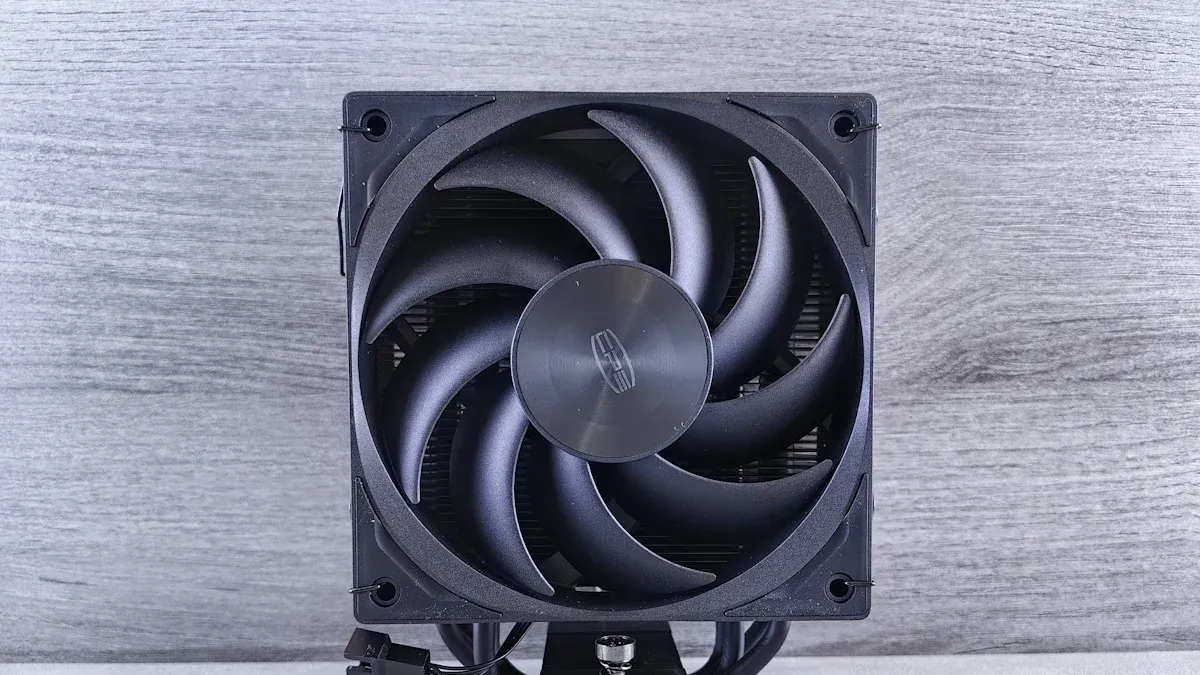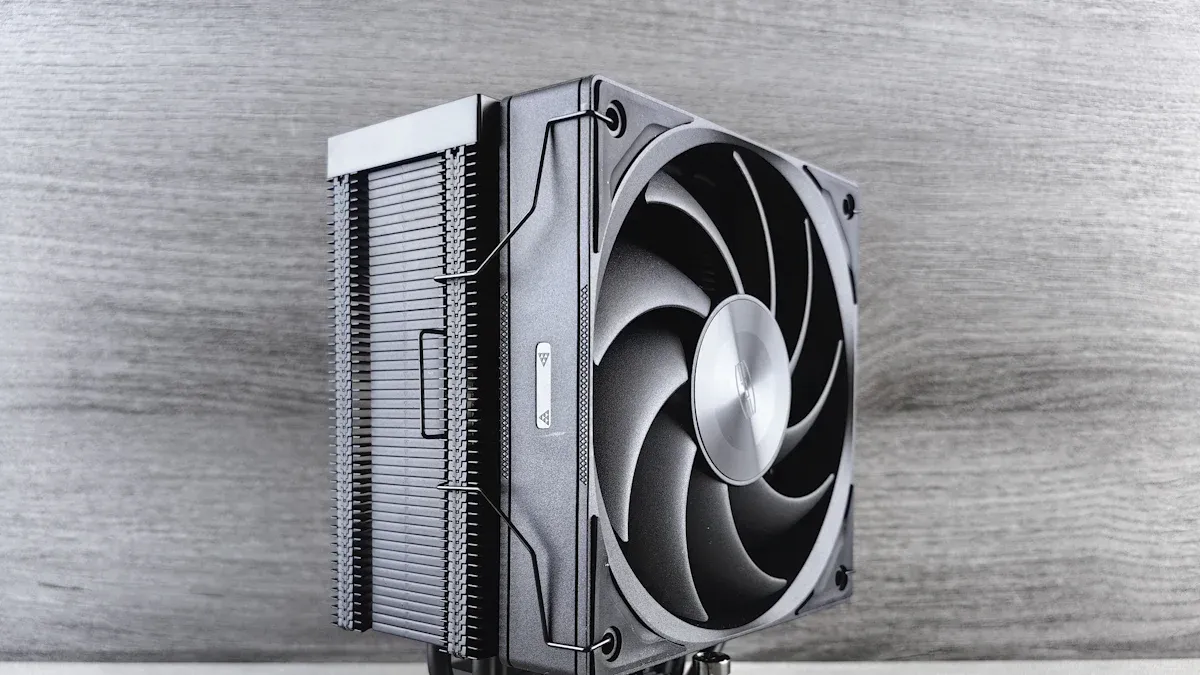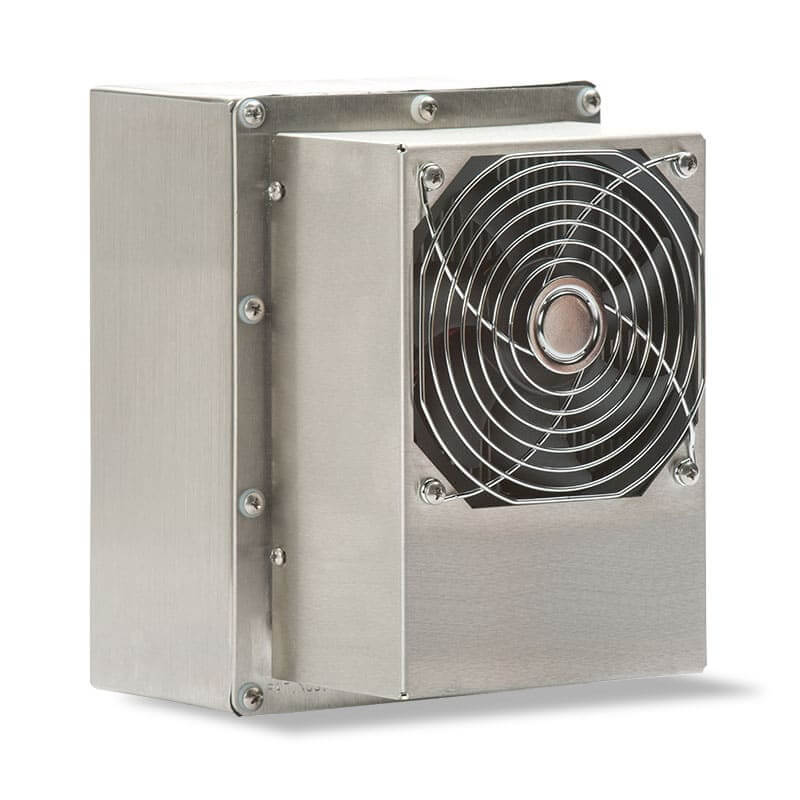Why Choosing Cabinet Fans Depends on Your Cooling Needs

You should choose a cabinet fan only when your cooling needs match its strengths. Many cabinets stay cool enough through natural convection, where warmer air rises and exits through vents at the top.
Vents at the bottom and top create a chimney effect, letting warm air escape without forced airflow.
Louvers and ventilated covers help keep dust out while allowing natural airflow.
Sparse fin patterns and vertical heat sink orientation improve cooling in fanless designs.
Before deciding, consider your environment, heat load, airflow resistance, and maintenance needs.
Key Takeaways
Choose cabinet fans when your equipment produces low to moderate heat and needs controlled airflow to stay cool and clean.
Cabinet fans work best in clean environments with low airflow resistance to ensure efficient cooling and longer fan life.
High backpressure and negative pressure inside cabinets reduce fan effectiveness and can cause dust buildup and uneven cooling.
Regular maintenance like cleaning filters and checking fans prevents failures, saves energy, and protects your equipment.
Consider passive cooling or expert advice if your heat load is high or your cooling needs are complex to find the best solution.
Cabinet Fan Basics

How Cabinet Fans Work
You need to understand how a cabinet fan operates before deciding if it fits your cooling needs. The main purpose of a cabinet fan is to move air through an enclosure, helping to remove heat from sensitive equipment. This process relies on several key steps:
The fan or blower pulls air through a pre-filter, which traps large dust particles.
Air then passes through a HEPA filter, removing almost all remaining particles.
The filtered air flows in a single direction, creating a laminar airflow that keeps the environment clean and prevents contamination.
The cabinet includes several components: the main body, a work station, pre-filter, fan or blower, UV lamp for sterilization, fluorescent lamp for lighting, and the HEPA filter.
You must follow specific steps for operation, such as cleaning, sterilizing with UV light, activating the blower to clear contaminants, working within the clean airflow, and shutting down with another cleaning cycle.
Laminar flow cabinets come in two types—vertical and horizontal—each offering different airflow directions and levels of protection.
Tip: Modern cabinet fans often use energy-efficient motors and smart sensors. These features help you save energy and monitor airflow and filter status in real time.
Understanding these basics helps you see why a cabinet fan works best when you need controlled, filtered airflow and when your equipment requires protection from dust or contaminants.
Typical Uses
You will find cabinet fans in many settings where heat and air quality matter. Their design makes them ideal for situations where you need to manage both temperature and cleanliness. Common uses include:
fanSINKs, which combine a fan and heat sink, cool electronics in edge computing and remote locations.
Electronics enclosures, where you select fans based on airflow rate, power use, and space constraints.
Data centers, where cabinet fans and accessories like airflow management panels lower equipment temperatures and prevent overheating.
Applications that require you to choose between axial and radial fans, depending on airflow direction and pressure needs.
A real-world example comes from data centers. When you install cabinet fans and airflow accessories, you can reduce the temperature of network switches by up to 12°F. This drop keeps equipment below critical temperature limits and improves reliability.
Note: You should always match the type and size of cabinet fan to your specific cooling and cleanliness requirements. This approach ensures you get the best performance and protect your equipment.
When Cabinet Fans Work Best

Low to Moderate Heat
You should choose a cabinet fan when your equipment generates low to moderate heat. Fans work best in environments where temperatures stay below extreme levels. When you keep the temperature under 39°C, you help your equipment stay safe and efficient. Fans can reduce heat stress and improve comfort for both electronics and people working nearby. If the temperature rises above 43°C, fans may actually increase strain and become less effective.
Temperature Range (°C) | Who Benefits | Fan Effectiveness |
|---|---|---|
Up to 37 | Older adults on medication | Safe, reduces heat stress, improves comfort |
Up to 38 | Older adults | Reduces cardiac strain by up to 86% at 60% humidity |
Up to 39 | Younger adults | Safe, improves thermal comfort |
36 (45% RH) | Healthy older adults | Reduces core temperature rise, lowers heart rate |
Above 43 | Healthy adults | May worsen heat stress, increases heart rate |
You see the best results from a cabinet fan when you operate it within these temperature ranges. This approach keeps your equipment running smoothly and avoids the risks that come with overheating.
Clean Environments
You get the most reliable performance from a cabinet fan in clean environments. Fans maintain strict cleanliness standards in places like semiconductor cleanrooms, where even tiny particles can cause problems. Studies show that fans keep temperature, humidity, and particle levels stable for long periods. For example:
Continuous monitoring in ISO class 5 cleanrooms shows fans keep temperature at 23 ± 1°C and humidity at 45 ± 5%.
Fans help remove particles and maintain airflow, supporting high air quality.
Ventilation systems with fans reduce pressure drops and keep the environment stable.
When you use a cabinet fan in a clean setting, you help protect sensitive equipment from dust and contamination. This reliability makes fans a smart choice for labs, electronics enclosures, and other controlled spaces.
Tip: You should always check the cleanliness of your environment before installing a fan. Clean surroundings help your fan last longer and work more efficiently.
Low Airflow Resistance
You should select a cabinet fan when your system has low airflow resistance. Fans deliver the most cooling when they do not have to push air through tight spaces or clogged filters. The airflow a fan provides depends on the balance between the fan’s pressure and the system’s resistance. When resistance stays low, fans can move more air and keep your equipment cool.
If your cabinet design allows air to flow freely, you get higher volume flow rates and better cooling. High resistance, such as from dense filters or narrow ducts, forces the fan to work harder and reduces its effectiveness. For example, a pressure loss of just 11 Pa can limit the airflow, so you need to make sure your system does not create unnecessary obstacles.
Cabinet fans perform best when you select them within the recommended Fan Efficiency Grade (FEG) windows, following standards like ANSI/AMCA 210 and ASHRAE 51.
System effects, such as the proximity of components and discharge orientation, can influence fan performance and energy use.
Manufacturers provide both component and equipment performance data, helping you choose the right fan for your specific setup.
When you reduce airflow resistance, you help your cabinet fan operate closer to its maximum capacity. This choice leads to better cooling and improved energy efficiency.
Cabinet Fan Limitations
High Backpressure
You need to understand why high backpressure can limit the effectiveness of a cabinet fan. When your cabinet has tight spaces, dense filters, or blocked vents, the fan faces resistance as it tries to move air. This resistance is called backpressure. High backpressure forces the fan to work harder, but it does not always result in more airflow. In fact, studies show that when you stack fans to overcome backpressure, the second fan often pulls in turbulent air from the first. This setup leads to minimal extra airflow and more noise.
Experimental and computer simulations confirm that high backpressure reduces the static pressure rise and efficiency of axial fans. The fan uses the same amount of power, but you get less cooling because the airflow drops. You also see more internal energy loss inside the fan. If you ignore backpressure, you risk overheating your equipment, even if the fan seems powerful enough on paper.
Performance charts from real-world studies show that blockages and poor enclosure design can cut fan flowrate by over 50% and static pressure by more than 75%. Radial fans handle high-resistance environments better than axial fans, but you still need to consider the total system design. You should always check for airflow restrictions before choosing a cabinet fan.
Note: High backpressure not only reduces cooling but also increases noise and energy waste. Always design your cabinet for smooth airflow.
Negative Pressure Effects
Negative pressure inside a cabinet can cause unexpected problems. When a cabinet fan pulls more air out than it brings in, you create a vacuum effect. This negative pressure can draw in dust and dirt through small gaps or unsealed doors. Over time, this contamination can damage sensitive electronics and lower the reliability of your system.
Improper airflow management can also lead to uneven cooling. Some areas may stay too hot, while others get too much airflow. This imbalance puts extra stress on certain components and can shorten their lifespan. You need to balance intake and exhaust airflow to avoid negative pressure and keep your equipment safe.
Tip: Use filtered intake vents and seal gaps to prevent dust from entering when your cabinet operates under negative pressure.
Maintenance Needs
You must consider maintenance when you rely on a cabinet fan for cooling. Dust and dirt are the main enemies of fan reliability. Maintenance records and reliability studies show that:
Dust and dirt can get into sensitive parts, causing malfunctions or even short circuits.
Debris buildup on cooling components blocks airflow, which leads to overheating.
Clogged air filters make the fan motor run hotter, especially in sleeve bearing fans, which can lose lubrication and fail.
Ball bearing fans last longer under high temperatures, but all fans need regular cleaning.
Fan failure often happens slowly. You may notice reduced airflow before the fan stops working completely.
Cleaning air filters and using compressed air helps prevent dust-related failures.
If you skip maintenance, your cabinet fan will lose efficiency. Data from telecom cabinets shows that well-maintained fans operate at about 0.55 to 0.60 kW/ton. Neglected fans drop to 0.90 to 1.0 kW/ton, which means you pay 20–25% more in energy costs. Regular cleaning and filter replacement protect your investment and keep your equipment cool.
Maintenance Condition | Efficiency (kW/ton) | Energy Cost Impact |
|---|---|---|
Well-maintained | 0.55 – 0.60 | Baseline |
Neglected | 0.90 – 1.00 | +20–25% |
The lifespan of a cabinet fan depends on quality, environment, and how often you maintain it. High-quality fans with sealed bearings last longer, but dust, heat, and humidity can still cause early failure. You should set a regular maintenance schedule and monitor fan performance to avoid surprises.
Alert: Ignoring maintenance increases the risk of overheating, higher energy bills, and unexpected equipment failures.
Assessing Your Needs
Heat Load
You need to know why understanding heat load is the first step in choosing the right cooling solution. If you underestimate the heat your equipment produces, you risk overheating and equipment failure. Industry case studies show that cooling needs can vary widely. For example, compact air conditioners for cabinets can handle up to 50,000 BTU/hr, while thermoelectric coolers manage only 155 to 390 BTU/hr. In data center experiments, increasing fan airflow reduced CPU temperatures by over 71% and cut energy use by 75%. These numbers show why you must measure your cabinet’s heat output before deciding if a cabinet fan is enough. If your heat load is high, you may need more advanced cooling.
Airflow and Pressure
You should ask why airflow and pressure matter so much for cabinet cooling. Poor airflow leads to hot spots and uneven cooling. Differential air pressure sensors help you spot leaks, blockages, and airflow problems. These sensors show if your cabinet has the right pressure balance for efficient cooling. Maintaining a slight positive pressure at the cabinet front keeps air moving through your equipment. You can use several metrics to check airflow quality:
Metric | What It Shows | Why It Matters |
|---|---|---|
How much cold air cools your equipment | Higher ASE means better cooling | |
Air Return Efficiency (ARE) | How well hot air returns to cooling units | High ARE prevents recirculation |
Mean Cabinet Recirculation Index (MCRI) | Hot air mixing into intake | Lower MCRI avoids hot spots |
Return Temperature Index (RTI) | Balance of supply and return air temps | RTI near 100% is ideal |
Supply Heat Index (SHI) | Hot air mixing with cold supply | Lower SHI means less heat gain |
These measurements explain why you must check airflow and pressure before installing a cabinet fan.
Maintenance Capacity
You need to consider why maintenance capacity affects your cooling choice. Regular cleaning and filter changes keep your system efficient. If you cannot maintain your cabinet fan, dust and dirt will build up, causing overheating and higher energy bills. Research shows that well-maintained fans use about 0.55 to 0.60 kW/ton, while neglected ones use up to 1.0 kW/ton. This difference means you pay more for energy and risk equipment failure. You should ask yourself if you have the time and resources for regular maintenance. If not, you may need a different cooling method.
Alternatives and Expert Help
Passive Cooling
You should consider passive cooling when your cabinet houses low-power equipment or sits in a well-ventilated area. Passive cooling uses natural airflow and heat dissipation, so you avoid energy costs and reduce maintenance. This method works best in shaded, temperate environments where outside temperatures stay moderate. You do not need to worry about fan noise or moving parts that can fail.
Here is a comparison to help you decide:
Aspect | Passive Cooling | Active Cooling (Cabinet Fans) |
|---|---|---|
Cooling Mechanism | Natural convection, conduction, radiation | Forced convection with fans |
Power Consumption | Zero | Requires electricity |
Noise | Silent | Generates noise |
Maintenance | Minimal | Needs regular cleaning |
Cooling Capacity | Limited, best for low heat loads | Handles higher heat loads |
Reliability | High for low loads | More complex, may be unnecessary for low loads |
You see that passive cooling is often the most efficient and reliable choice for low heat loads. You should only use a cabinet fan if your equipment generates more heat than passive methods can handle.
Other Cooling Options
You may need to look beyond cabinet fans if your equipment produces a lot of heat. High-power setups, such as dense data centers, often require advanced cooling. Studies show that liquid cooling—using water or refrigerant—can cut operating costs by up to five times compared to air cooling. Liquid systems also reduce fan noise and energy use, especially at high power densities. You should choose these alternatives when you need to manage extreme heat or want to lower long-term costs.
Air cooling with cabinet fans works for moderate heat loads.
Water-based liquid cooling uses coldplates and coolant for better efficiency.
Refrigerant-based cooling offers the lowest operating costs and minimal maintenance.
When to Consult an Expert
You should consult a cooling expert when you face complex or persistent problems. If basic steps like checking clearances, cleaning filters, or inspecting wiring do not solve the issue, an expert can help. You also need professional advice for safety-related shutdowns, error codes, or advanced diagnostics. Experts use specialized tools and knowledge to ensure your system runs safely and efficiently.
Tip: Always document any tests or error codes before calling an expert. This information speeds up troubleshooting and repair.
You should always match a cabinet fan to your unique cooling needs. Consider heat load, airflow resistance, environment, and maintenance before making a decision. Data center monitoring shows that tailored cooling solutions improve equipment reliability and efficiency. Studies highlight that optimizing airflow and cooling methods can boost performance by nearly 60%. If you feel unsure, explore passive options or consult an expert. The right cooling choice protects your equipment and keeps your system running smoothly.
FAQ
Why should you avoid using a cabinet fan in a dusty environment?
Dust can clog your fan and filters. This buildup reduces airflow and increases the risk of overheating. You will spend more time on maintenance and cleaning. Choosing a fan in a dusty area often leads to higher costs and more frequent failures.
Why does airflow resistance matter when choosing a cabinet fan?
High airflow resistance makes your fan work harder. You get less cooling and more noise. If you ignore resistance, your equipment may overheat. Always check for blockages or tight spaces before you install a fan.
Why is regular maintenance important for cabinet fans?
Regular maintenance keeps your fan running efficiently. Dust and dirt can block airflow and cause your fan to fail early. You protect your equipment and save on energy costs when you clean and check your fan often.
Why might passive cooling work better for your cabinet?
Passive cooling uses natural airflow. You avoid fan noise and reduce energy use. If your equipment produces little heat, passive cooling can keep it safe without extra maintenance or cost.
Why should you consult an expert before upgrading your cabinet cooling?
Experts help you match the right cooling method to your needs. They check heat load, airflow, and pressure. You avoid costly mistakes and protect your equipment by getting professional advice.
See Also
Selecting The Optimal Cooling Technique For ESTEL Telecom Cabinets
Exploring Various Cooling Solutions And Their Uses In Telecom Cabinets
Guide To Choosing The Ideal Outdoor Electrical Cabinet For You
Benefits Of ESTEL Cooling Systems For Industrial Cabinet Use
The Importance Of Air Conditioning In Outdoor Communication Cabinets
CALL US DIRECTLY
86-13752765943
3A-8, SHUIWAN 1979 SQUARE (PHASE II), NO.111, TAIZI ROAD,SHUIWAN COMMUNITY, ZHAOSHANG STREET, NANSHAN DISTRICT, SHENZHEN, GUANGDONG, CHINA

